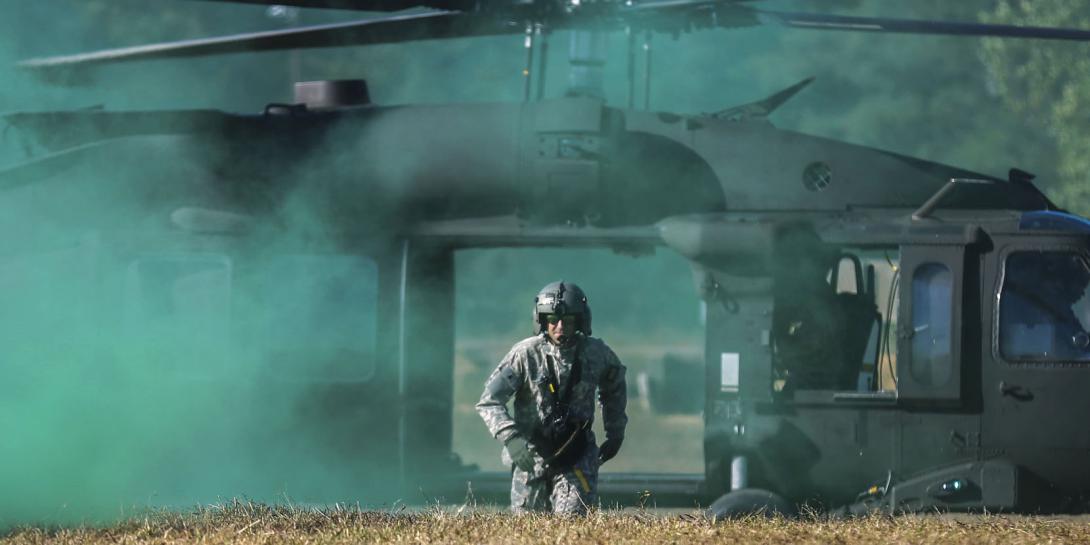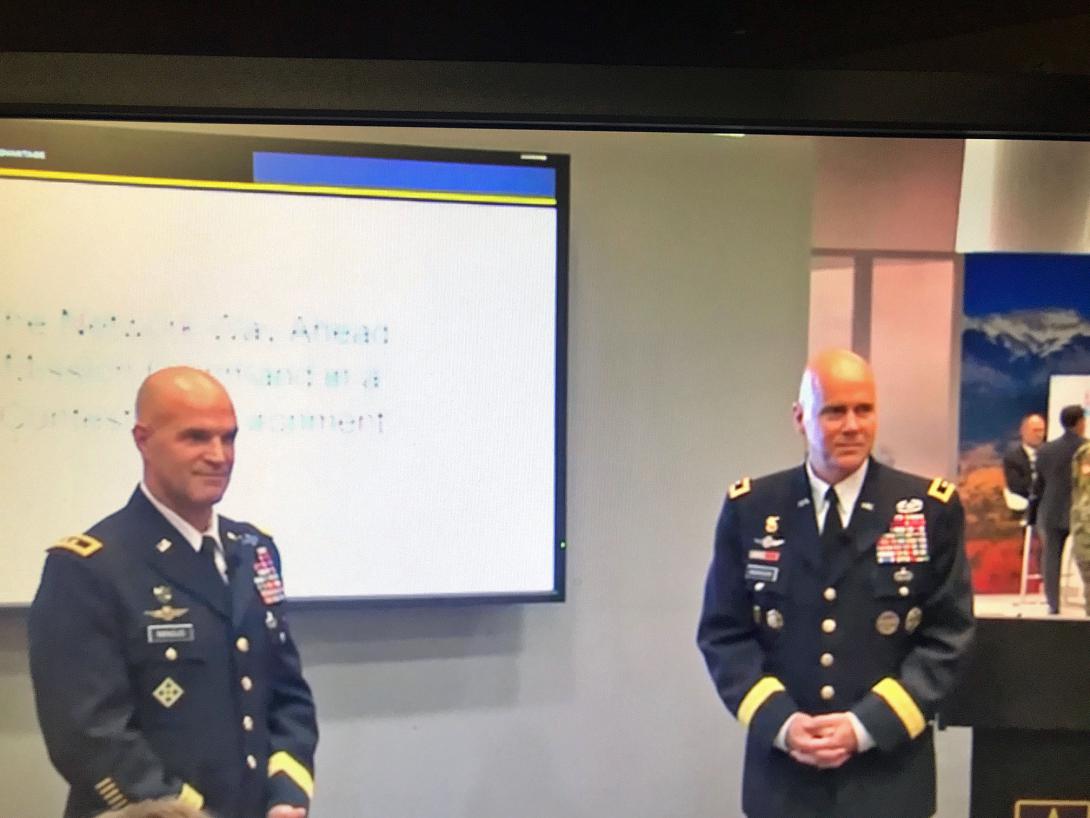Army Eyes Network of the Future
To say that the Army’s network needs an update is an understatement. The 1.1 million user-network has, among other things, 17 mission command systems—all “stovepiped,” designed never to interact together. Some of the systems were used in the early 2000s to fight a static war in Iraq and Afghanistan.
That won’t fly for today’s battlefield, the Army has found. And the change can’t come soon enough, explained Maj. Gen. John Morrison, USA, commanding general, U.S. Army Cyber Center of Excellence; and Maj. Gen. James Mingus, USA, director, Mission Command Center of Excellence. The generals presented the Army’s plan for the network of the future at the Association of the U.S. Army (AUSA) Annual Meeting in Washington, D.C., on October 10.
“If you think about how the enemy has developed his architecture on the other end and how the enemy has built his fires apparatus to both blind and create extensive standoffs, unless we do some things to our network, unless we do some things to our mission command systems and unless we do some things to our command post infrastructure, it is our belief that our network will not survive against a near-peer or peer competitor,” Gen. Mingus warned.
In fact, modernization of the network is one of the main priorities for the Army—coming fourth in a line of six priorities laid out at AUSA, including long-range precision; a next-generation vehicle; vertical lift; air and missile defense; and soldier lethality. Designing the future network involves the Army’s top brass. “The chief [39th Chief of Staff for the U.S. Army Gen. Mark Milley] personally took this one on in March,” Gen. Mingus shared.
So how to tackle modernizing such a network, all while preparing “to fight tonight?” First, conduct a top-to-bottom review of every component of the network and every program—“what was good, bad and what we needed to do differently,” Mingus said. No one had done an extensive review like that “in quite some time.”
“As we went through the system, it wasn’t only about the operational capabilities of the individual systems,” Gen. Morrison clarified. “It was all aligned against a near-peer threat and what has changed since we wrote requirements for those systems, in some cases more than a decade ago.”
After studying the “broad problem” for about three months, the generals found that the system includes thousands of disparate networks and databases, from the Joint Staff and Office of the Secretary of Defense level, on down. “As you come inside the Army, there are 15 organizational and 5 functional networks and hundreds of associated databases,” Gen. Mingus said. “Then, at the tactical level, our radios, transport mechanisms and mission command systems were never designed never to talk to one another in a seamless way.” To operate the network, the Army has had to “make it work” through modifications and patches.
The current system was built to fight in a counter insurgency environment, and over the last 15-16 years in combat, the United States’ adversaries “have gone to school on how we do business” in terms of the network, Gen. Morrison said. “And quite frankly, we’ve let some of our capability degrade. Now we need to build that resiliency inherently into the network to support our mission command.”
A robust network must be secure, and include voice, data, video, operate anywhere at anytime, be standardized and upgradable, Gen. Mingus stated. It must enable rapid task organization, be flexible and dynamic, and to a certain extent, be accessible to partners and allies.
It’s a tall order, but the Army must build a common network infrastructure that is defensible, yet converges all of their networks, data centers, identity management systems and a unified transport layer into a common operating environment, the generals stressed. The unique warfighting applications—such as fires, intel and maneuver—will no longer be standalone systems; they will still be separate applications but they will be integrated.
At its core, the Army network must reflect warfighters’ requirements to fire, shoot, move, communicate, protect and sustain at the command level.
"It’s now an environment where you have to move your command post every 30 to 60 minutes,” Gen. Morrison stated. “We’ve already seen what’s happened over in Europe. Those command posts that did not move rapidly were targeted, through non-kinetic strikes, and then eventually with very, very kinetic long-range precision fires. The casualties were catastrophic.”
Essentially, the Army needs to treat aspects of the network “like a weapon,” added Gen. Mingus. “Just like an artillery system, if it hasn’t shot in three hours, it’s probably going to move. If it has shot, it needs to move. We have to think of our command post, and think about our network in a very, very similar vein.”
To transform the system, the Army will begin by halting programs that cannot sufficiently be remedied; fixing programs that are still needed “to fight tonight;” and pivoting to an “adapt and buy” approach for commercially available technologies.
For command post and common operating environments, the Army will begin two prototype experiments in Fiscal Year 2018 designed to get back mobility, agility and survivability. First, it will “very rapidly” bring in intermodal containers, expandable vans, shelters, wireless technologies and smart power to “several echelons” throughout the Army. This experimentation will look at various combinations of technologies at the command level, Gen. Mingus explained. For the second project, several brigade combat teams will begin hardware integration and form fit adjustments to prepare for seamless integration of the future command and control systems. Both experiments will then inform the Army’s move to long-term programs for the whole service. At the same time, the approach will harness upgradability.
“We don’t want to hit a home run every time,” Gen. Morrison offered. “So we what we want to do is experimentations, then develop requirements, make sure of what we want to do moving forward, then in three-to-five year sprints procure what we need to, so we can iteratively improve the systems over time.”
The Army also will be changing its business model for tactical radios. “Gone are the days that we specify a technical waveform,” Gen. Morrison said. The Army will take a “best value approach,” in which they will ask the industry to bring in available waveform technologies on a given box. The Army will make adjustments to find the best value operationally that gives them multiband and multimode radio optionality.
Importantly, this pivot and buy approach will give Army commanders choice. The Army will do market research and experiment to find the best hardware, and then “cascade” in new technologies. “We will buy less of it, more often,” said Gen. Mingus.







Comments